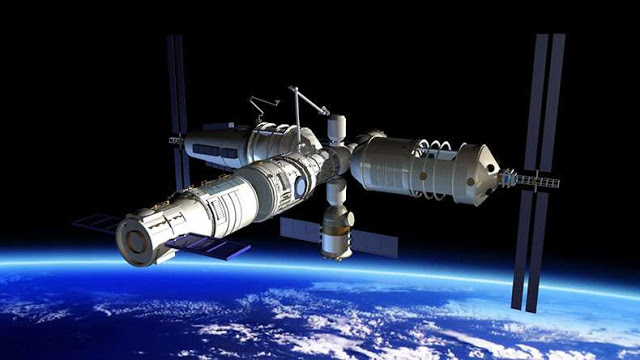
An internet imagery.
BEIJING (PTI): China on Thursday night successfully launched its second experimental space lab as part of an ambitious programme by the Communist giant to build a manned space station by 2022, the time when US-led International Space Station expected to go out of service.
The Tiangong-2 space lab was successfully launched from the Jiuquan Satellite Launch Centre in northwestern China's Gobi desert.
"It was text book launch. It reached the designated orbit in about 10 minutes," an official in-charge of the mission announced over the state-run TV which telecast the launch live.
"The mission is complete success and the space lab reached its designated orbit," the official said.
China's manned space program has now entered a new phase of application and development," Wu Ping, deputy director of China's manned space engineering office, said.
In a cloud of brown smoke, Tiangong-2 roared into the air underneath a mid-autumn full moon from the Jiuquan Satellite Launch Center on the back of a Long March-2F rocket, trailing a vast volume of flame, the official Xinhua news agency reported.
China's ambitious space programme aims for a manned space station by 2022. China's space station is expected to be sent into orbit just as the US-led International Space Station goes out of service -- making China potentially the only country with a permanent space presence.
The 8.6-tonne space lab will manoeuvre itself into an orbit about 380 kms above the Earth for initial on-orbit tests.
It will transfer to a slightly higher orbit at about 393 kilometers above the Earths surface by next month before a manned space ship called Shenzhou-11 would ferry two astronauts into space to dock with the lab.
The two astronauts will work in Tiangong-2 for 30 days including manual and automatic docking before reentering the Earths atmosphere.
In April 2017, China's first cargo ship Tianzhou-1, which literally means "heavenly vessel," will also be sent into orbit to dock with the space lab and provide it with fuel and other supplies.
China, which conducted its first manned space mission in 2003 also plans to launch its Mars mission in 2020 to catch up with India, the US, Russia and the EU to reach the red planet.
As it launched the second space station, China on Wednesday announced that its first space lab Tiangong-1 is expected to fall into the Earth's atmosphere in the latter half of 2017.
Tiangong-1 was launched in September, 2011 and ended its data service in March this year, when it had "comprehensively fulfilled its historical mission," Wu Ping, deputy director of the manned space engineering office told media on Wednesday.
The space lab is currently intact and orbiting at an average height of 370 kilometers, she said.
It was in service for four and a half years, two and a half years longer than its designed life, and had docked with Shenzhou-8, Shenzhou-9 and Shenzhou-10 spacecraft and undertaken a series of tasks, making important contributions to China's manned space cause, Wu said.
"Based on our calculation and analysis, most parts of the space lab will burn up during falling," she said, adding that it was unlikely to affect aviation activities or cause damage to the ground.
China has always highly valued the management of space debris, conducting research and tests on space debris mitigation and cleaning, Wu said.
Now, China will continue to monitor Tiangong-1 and strengthen early warning for possible collision with objects.
If necessary, China will release a forecast of its falling and report it internationally, Wu said.
China will begin building a space station that is more economically efficient and uses more data than the current International Space Station (ISS), starting from next year, chief engineer of China's manned space programme Zhou Jianping said.
"Once the space lab mission comes to an end, China will start building our own space station," he told state-run Xinhua news agency, adding that China will launch a core module of the space station around 2018.
China's space station will consist of three parts, weighing over 60 tonnes, said Zhou, adding that it will be smaller than the ISS and be able to dock with two manned spacecraft and one cargo spacecraft at most.
Zhou said the station is designed to house a maximum of six astronauts.
"After the building of the space station, manned space flight will become normal, which means China will send at least six astronauts in two groups to space each year," he added.
Zhu Zongpeng, chief designer of China's space lab system, said construction of the space station will be completed by around 2020 and it will enter into service around 2022, with an initial designed life of at least 10 years.
Astronauts could soon be stationed in orbit for missions that last more than one year, Zhu said.
China has been actively developing a three-step manned space programme.
The first step, to send an astronaut into space and return safely, was fulfilled by Yang Liwei in the Shenzhou-5 mission in 2003.
The second step was developing advanced space flight techniques and technologies including extra-vehicular activity and orbital docking.
This phase also includes the launch of two space laboratories - effectively mini space-stations that can be manned on a temporary basis.
The next step will be to assemble and operate a permanent manned space station.
 Previous Article
Previous Article Next Article
Next Article













The Indian Air Force, in its flight trials evaluation report submitted before the Defence Ministry l..
view articleAn insight into the Medium Multi-Role Combat Aircraft competition...
view articleSky enthusiasts can now spot the International Space Station (ISS) commanded by Indian-American astr..
view article